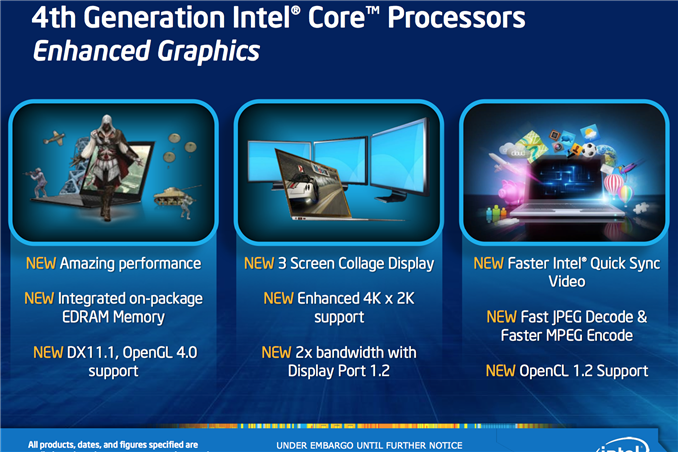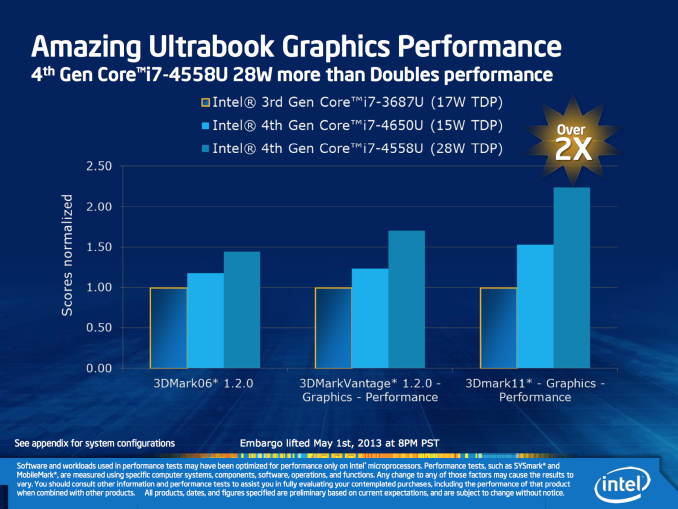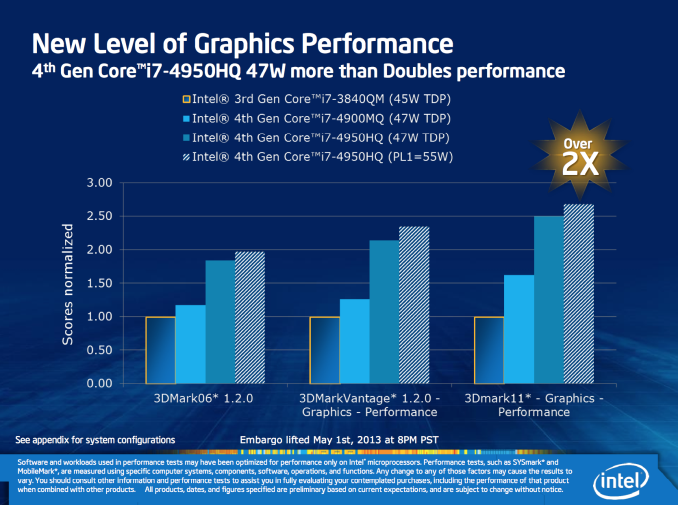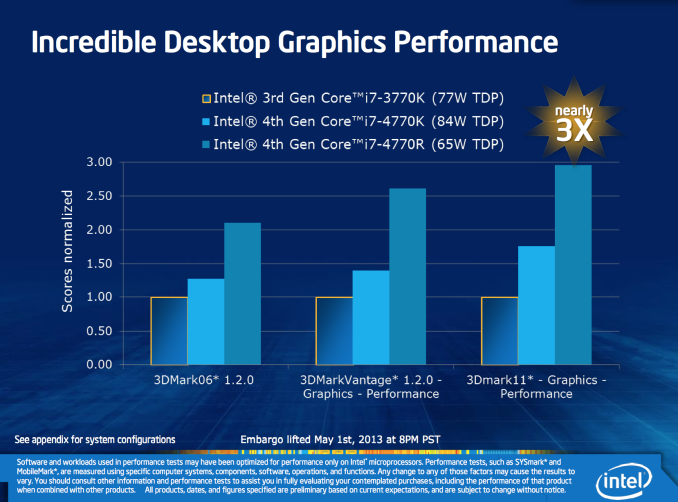Intel Iris & Iris Pro Graphics: Haswell GT3/GT3e Gets a Brand
by Anand Lal Shimpi on May 1, 2013 11:00 PM EST
We’ve known for a while that Intel’s Haswell processor would continue to drive GPU performance in a significant way. With Haswell, Intel will offer a higher end graphics configuration with more execution resources than before (GT3) as well as an even higher end offering that pairs this GPU with 128MB of embedded DRAM on the CPU package (GT3e). Intel’s performance target for the highest end configuration (GT3e) is designed to go up against NVIDIA’s GeForce GT 650M, a performance target it will hit and miss depending on the benchmark.
Regardless of whether or not it wins every benchmark against the GT 650M, the fact that an Intel made GPU can be talked about in the same sentence as a performance mainstream part from NVIDIA is a big step forward. Under no circumstances could Intel compete with NVIDIA on performance and still do so under the Intel HD Graphics brand. Haswell is the beginning of a new era for Intel. The company is no longer a CPU company forced into graphics, but with Haswell Intel begins its life as a GPU company as well. As a GPU company, Intel needs a strong GPU brand. AMD has Radeon, NVIDIA has GeForce, and now Intel has Iris.
The brand is a nod to a long forgotten history of 3D graphics, as well as an obvious reference to the fact that GPUs are used for very visual purposes. Before OpenGL was well, open, it was a project known as IrisGL.
Intel is doing the right thing with Iris and only using it to refer to its absolute best graphics options. Intel HD Graphics will remain, and will refer to all GT1/GT2 and some GT3 configurations with Haswell. Iris and Iris Pro will be used to refer to high end GT3 and GT3e configurations:
Anything with GT3e will have Intel’s Iris Pro 5200 graphics, while 28W SKUs with GT3 will have vanilla Iris 5100 (non-Pro). Any 15W SKUs with GT3 will be HD Graphics 5000, and GT2/GT1 parts will also be identified as Intel HD Graphics.
We know what makes Iris Pro special (128MB of eDRAM), but it appears that the main difference between Iris 5100 and HD 5000 is max GPU clock speed. Intel wants Iris associated with performance, which is a very good thing. Having Iris reach down into non-GT3e parts as well is a bit unsettling but at least GT3e gets the Pro designation.
Intel claims Iris/Iris Pro will deliver up to 2x better performance than Intel’s HD 4000 graphics in notebooks, and it’s using 3DMark11 to validate that claim:
Although Ultrabooks (now 15W) won’t get full blown Iris performance, they should still see a healthy increase in GPU performance compared to where they are today (50% improvement in 3DMark) at a lower TDP. The move to a full speed GT3 part (Iris) should more than double performance in 3DMark. Also worth noting is the fact that we now have a 28W ULT part (i7-4558U). This is a part designed for larger Ultrabooks (14/15"+) that would otherwise have a low end discrete GPU.
Iris Pro will be exclusive to quad-core parts, and the advantage there grows to 2.5x in 3DMark11. There's a slight increase in processor TDP here, but obviously much better performance. That last bar is with the i7-4950HQ running with its TDP set to 55W (cTDP up).
BGA (non-socketed) desktops will also have the option of using Iris Pro if you get an R-series SKU. The performance gains there over Intel HD 4000 are even more impressive thanks to the additional TDP headroom:
QuickSync performance will also improve as a function of increased number of EUs. There’s also DX11.1, OpenCL 1.2, OpenGL 4.0 and 4Kx2K support.
This is really the beginning of a new era. Intel isn't talking specifics about power savings here, but that's really where Iris and Iris Pro will shine. The fact that performance will finally be reasonable enough to actually play games is just icing on the cake. Kicking discrete GPUs out of non-gaming focused notebooks and replacing them with Iris Pro parts should keep performance high while significantly reducing power consumption.
With Iris Intel is finally committed to graphics, and that's a very good thing.















104 Comments
View All Comments
makerofthegames - Thursday, May 2, 2013 - link
On the low end, yes. Discrete cards are quickly becoming a thing only for gamers and 3D professionals (as well as those needing heavy compute power). But that could be a more high-margin market for them, compared to integrated graphics. And with minimal R&D costs on top of the work they've already done for the iGPUs, the margins are even higher.It makes sense to at least try it, on the small scale. Whether it makes sense in the context of their broader strategy is beyond my ability to guess.
Azethoth - Thursday, May 2, 2013 - link
No you are missing the big picture. The MhZ race ended in mid 2000s due to heat. Now we are into multiple cores. However that only buys you something if you can in fact make a particular workload parallel. So now you are sitting there with the ability to have 16 cores due to process improvements but 4 cores were already plenty.The obvious answer is to bring more stuff on chip. From Memory controllers to GPU and physics chips there will be more and more non CPU stuff built in over time. It may be true today that you are better off with the GPU on a separate card. In a few years though there will be plenty of room on board. Couple that with unified GPU / CPU / whatever memory and you quickly get a single chip solution that is superior to anything discrete simply due to off chip bandwidth limitations.
Haydon987 - Friday, May 3, 2013 - link
Yes things are moving this way, but keep in mind that this "amazing ultrabook graphics performance" is approximately 7x slower than the flagship dedicated GPU already being sold by NVIDIA. While that is an improvement over previous generations, we're still at least a decade or more out from any real convergence on the high end of the GPU market.So right now, at this moment in time in the market, it would make more sense to pair the high end integrated GPU with the lower performance CPUs because anyone buying a 4770K, for instance, is in all probability going to also be buying a GPU closer to that flagship level of performance on the GPU side of things.
rituraj - Thursday, May 2, 2013 - link
Just release it alreadyA Lenovo thinkpad helix with i7 + iris.. god I am .... oh god...
superjim - Thursday, May 2, 2013 - link
If Richland gets the estimated 20% bump over Trinity, I'm wondering what the highest end GPU we will see in Ultrabooks will be. 8670 vs GT3? Keep in mind the 35W A10-4657M is already in the 14" Vizio CT14T-B0 with a 7660g so if AMD can cram that in an ultrabook, I don't see why a 5100 wouldn't be possible.alfredska - Thursday, May 2, 2013 - link
Why do we not have a "Flag as spam" link?nixtish - Thursday, May 2, 2013 - link
Which one of these SKU's do you guys think would make it into the next gen rMBP ?Ktracho - Thursday, May 2, 2013 - link
I would guess 28W GT3 for 13" MBP and 15W GT3 + discreet graphics for 15" MBP.karamazovmm - Saturday, May 4, 2013 - link
So apple would put a lower performing part in the rmbp 13 2013 than what they had at launch? Complicated business decisionbrvnbld - Thursday, May 2, 2013 - link
No way Intel is gonna compensate for the desktop graphics just by introducing CPU that comes with graphical components. IMO Intel is a conservative brand, AMD might not be competent with Intel in terms of performance, but price/performance ratio is good for AMD products, and i like the way AMD taking bold steps in GPU/CPU .